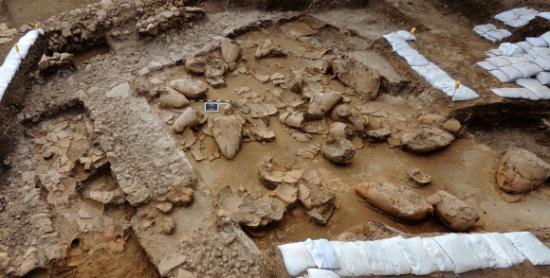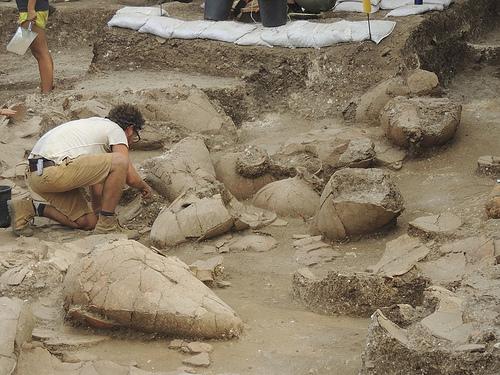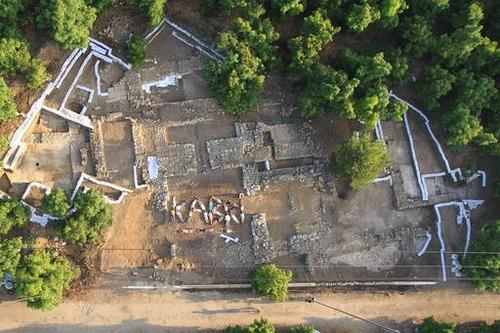Cellar held equivalent of nearly 3,000 bottles of reds and whites; findings to be released Friday
George Washington University
Source - http://www.eurekalert.org/pub_releases/2013-11/bu-adl112013.php

These 3,700-year-old jars were discovered in an ancient palatial wine cellar unearthed by researchers at Tel Kabri in July 2013. The team worked in day and night shifts to excavate a total of 40 intact vessels during its six-week dig. Credit: Eric H. Cline, George Washington University
A team of American and Israeli researchers has unearthed what could be the largest and oldest wine cellar in the Near East.
The group made the discovery at the 75-acre Tel Kabri site in Israel, the ruins of a northern Canaanite city that dates back to approximately 1700 B.C. The excavations at the vast palace of the rulers of the city are co-directed by Eric H. Cline of the George Washington University (GW), and Assaf Yasur-Landau of the University of Haifa, with Andrew Koh of Brandeis University as associate director. As researchers excavated at the site, they uncovered a three-foot-long jug, later christened "Bessie."
"We dug and dug, and all of a sudden, Bessie's friends started appearing—five, 10, 15, ultimately 40 jars packed in a 15-by-25-foot storage room," said Dr. Cline, chair of GW's Department of Classical and Near Eastern Languages and Civilizations within the Columbian College of Arts and Sciences. "This is a hugely significant discovery—it's a wine cellar that, to our knowledge, is largely unmatched in its age and size."

Ruins of the 3,700-year-old wine cellar unearthed at Tel Kabri. Image credit: Eric Cline / George Washington University.
The findings will be presented on Friday in Baltimore at the annual meeting of the American Schools of Oriental Research.
The 40 jars have a capacity of roughly 2,000 liters, meaning the cellar could have held the equivalent of nearly 3,000 bottles of reds and whites.

The team worked in day and night shifts to excavate a total of 40 intact 3,700-year-old vessels in the ancient palatial wine cellar during its six-week dig in July 2013. Credit: Eric H. Cline, George Washington University
"The wine cellar was located near a hall where banquets took place, a place where the Kabri elite and possibly foreign guests consumed goat meat and wine," said Dr. Yasur-Landau, chair of the Department of Maritime Civilizations at the University of Haifa. "The wine cellar and the banquet hall were destroyed during the same violent event, perhaps an earthquake, which covered them with thick debris of mud bricks and plaster."

This image of the Tel Kabri wine cellar was created using LIDAR, a technique that uses a pulsed laser to measure distances and generate an accurate 3D map of a location. LIDAR helped the archaeologists map the storage room and each of the 40 wine jars discovered in July 2013. Courtesy Tel Kabri Archaeological Project
It wasn't immediately clear it was wine the jugs once held. To make that determination, Dr. Koh, an assistant professor of classical studies at Brandeis University and associate director of the excavation, analyzed the jar fragments using organic residue analysis. He found traces of tartaric and syringic acids, both key components in wine, as well as compounds suggesting the presence of ingredients popular in ancient wine-making, including honey, mint, cinnamon bark, juniper berries and resins. The recipe is similar to medicinal wines used for 2,000 years in ancient Egypt.
"This wasn't moonshine that someone was brewing in their basement, eyeballing the measurements," Dr. Koh said. "This wine's recipe was strictly followed in each and every jar."
Researchers now want to continue analyzing the composition of each solution, possibly discovering enough information to recreate the flavor.
Luckily, they'll have more evidence in a couple of years. A few days before the team members wrapped up work this summer, they discovered two doors leading out of the wine cellar—one to the south, and one to the west.
Both probably lead to additional storage rooms. They'll have to wait until their next dig in 2015 to find out for sure.

An aerial view of Tel Kabri. Among other objectives, researchers are investigating the site to obtain clues as to what drove the economy of the area. Courtesy Skyview Photography, Ltd.
###
Funding for this research was provided by GW, the University of Haifa, the National Geographic Society, the Israel Science Foundation, the Institute for Aegean Prehistory, Bronfman Philanthropies and private donations.